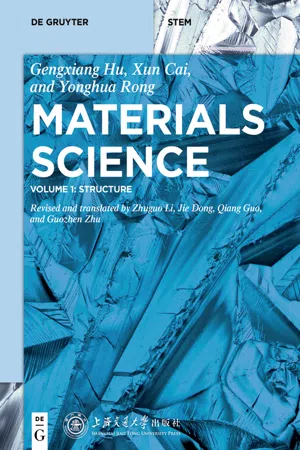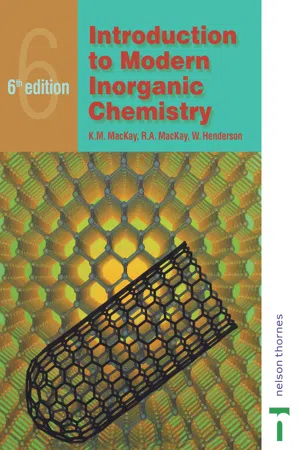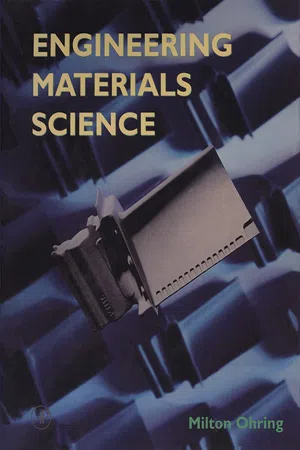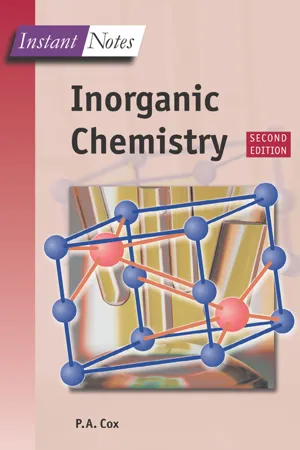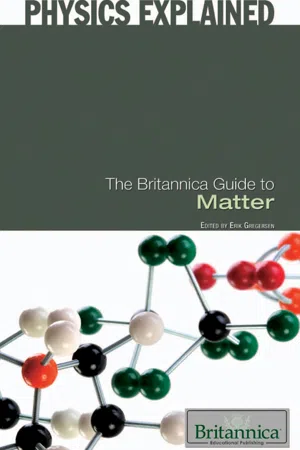Chemistry
Structure of Ionic Solids
Ionic solids are composed of positively and negatively charged ions held together by electrostatic forces. The structure of ionic solids is characterized by a repeating three-dimensional lattice arrangement, with ions occupying specific positions within the lattice. This arrangement results in a strong and stable structure, contributing to the high melting and boiling points typically observed in ionic compounds.
Written by Perlego with AI-assistance
Related key terms
Related key terms
1 of 4
Related key terms
1 of 3
6 Key excerpts on "Structure of Ionic Solids"
- eBook - ePub
- Gengxiang Hu, Xun Cai, Yonghua Rong(Authors)
- 2021(Publication Date)
- De Gruyter(Publisher)
The positive and negative ions must have a certain short-range repulsion to balance with the electrostatic attraction to form a stable crystal. The rejection effect of the short-range repulsion is attributed to the Pauli principle: when two ions are further closer to each other, the electron clouds of the positive and negative ions overlap, and then the electrons tend to make a comovement between the ions. Since these ions have a full shell structure, the codominated electrons tend to occupy the higher energy level so that the energy of the system is increased accompanying with a strong repulsion. The balance of the repulsive interaction and the electrostatic attraction results in the formation of a stable ionic crystal.In the study of crystal structures for a long time, some rules of the crystal structure of ionic compounds are found from a large number of experimental data, as well as the crystalline chemistry theory. Before describing structures of the typical ionic crystals, the structural rules of ionic crystal are first introduced.2.4.1 Structural rules of ionic crystals
Based on a plenty of experimental investigations L. Pauling summarized the structural rules of ionic crystals by using the theory of ionic bond as follows.1. Rules of anionic coordination polyhedral
Pauling considered that in the ionic crystals, an anion coordination polyhedron forms around a cation. Also, the balance distance between the positive and negative ions depends on the sum of the ionic radii, while the coordination number of positive ions depends on the ratio of ionic radii. This is Pauling’s first rule, which is consistent with the principle of the minimum internal energy. When this rule is applied, the structures of ionic crystals can be considered that it consists of anion co-ordination polyhedrons connected in a certain way, in which the cations are located at the center of the negative ion polyhedron. Therefore, we can say that the coordination polyhedron is the structural unit of the ionic crystals.In order to reduce the total energy of the ionic crystals, the positive and negative ions tend to form close-packed structures with each other as many as possible. A positive ion tends to connect to more negative ions. In other words, one stable structure should have a coordination number as large as possible, while the coordination number depends on the ratio of the negative and positive ion radii, as shown in Table 2.18 . Besides, the structure of the ionic crystal is stable only when the positive and negative ions are in contact with each other. Therefore, for a given coordination number the ratio of the critical ion radius R+ /R− - R.A. Mackay(Author)
- 2017(Publication Date)
- CRC Press(Publisher)
Finally we may pick out the class of metals which are related to the giant molecules but where the outer electrons are free to move throughout the crystal. Such crystals show a range of hardness and melting points, and are highly reflecting and conducting.These four classes are idealized cases and a range of interactions apply in most solids (compare also the discussion based on Fig. 5.11 in Section 5.6 ). We start this chapter with ionic crystals, where the basic interactions are well understood, and we go on to relate other types of solid to these.Simple ionic crystals
5.1 The formation of ionic compounds
In the last two chapters, the Lewis electron pair theory was extended on the basis of wave mechanics to give a full description of the covalent bond. In this section, ionic bonding will be examined and the various factors which determine the formation and stability of ionic compounds will be discussed.The basic process in the formation of an ionic compound is the transfer of one or more electrons from one type of atom to another: the resulting ions are then held together by electrostatic attraction.Isolated ionic species, such as the two-atom entity M+ X – , do not exist under ordinary conditions. In ionic compounds, we are dealing with an array of ions, which extends in three dimensions to the edges of the crystallite. If the ionic solid dissolves, the ions are indeed separated, but they are stabilized by interaction with the solvent molecules (see Chapter 6 ) and the free ion has only a transient existence.The arrangement of the ions in the solid is the one which gives the highest electrostatic energy. To see what factors determine this arrangement, consider the process of bringing up successive anions around a given cation. If there are already π anions surrounding the cation, the addition of a further anion produces an extra attraction between its charge and the cation charge, and also produces a number of repulsions between its charge and the charges on the π- eBook - ePub
- Milton Ohring(Author)
- 1995(Publication Date)
- Academic Press(Publisher)
3STRUCTURE OF SOLIDS
3.1 INTRODUCTION TO CRYSTAL STRUCTURE
Although the previous chapter developed models of solids based on the electronic structure of atoms, it was largely done without assumptions as to how atoms were physically arranged or positioned relative to each other. In this chapter an almost opposite viewpoint is adopted: the physical structure is our primary concern and the electronic structure is of secondary interest. Of course, at a deeper level the two types of structures are intimately coupled. The richness in the diversity of materials properties is attributable to the countless combinations of different atomic species, their electronic constitution, and the way atoms are geometrically arranged within solids.It is convenient to subdivide the structure of solids into two broad categories: crystalline and noncrystalline or amorphous . Many solids have a crystalline structure that is described by an ordered geometric array of atoms that stretches endlessly in all directions in a repetitive fashion. We do not think of materials like structural steel and solder as being crystalline because they are not clear, transparent, faceted, sparkling, angular, and so on. Despite external appearances to the contrary, materials like metals are, in fact, crystalline based on the scientific criterion of an orderly internal arrangement of atoms. On the other hand, atoms are not positioned in predictably ordered arrays in amorphous solids like silica glass and most hydrocarbon polymers.In this chapter we are concerned with a description of the structure of crystalline solids. Although crystals have been known, and some even fondled for thousands of years, it is only in the last century that they have been classified. To create actual crystal structures one must first imagine a three-dimensional array of points in space distributed such that each has identical neighbors. There are only 14 ways to arrange points in space having this geometrical property. These special point arrays are known as Bravais point lattices . It must be appreciated that the space of any one of these point lattices can be delineated into cells in a number of arbitrary ways. The lines drawn in Fig. 3-1 have been found to be the most convenient way to outline unit cells of points that can be used to distinguish each of the Bravais lattices. Table 3-1 summarizes the lengths and interaxial angular relationships among the 14 unit cells that can be further classified as belonging to one of seven crystal systems. The unit cell dimensions, a , b , and c are known as lattice parameters - eBook - ePub
- Jeffrey Gaffney, Nancy Marley(Authors)
- 2017(Publication Date)
- Elsevier(Publisher)
Chapter 11Solids
Abstract
This chapter reviews the types of solids including their chemical structure and properties. The seven types of crystal lattice structures and the four substructures are explained. Types of crystalline solids covered are ionic solids, molecular solids, atomic solids, and metallic solids. Discussions of ionic solids include the determination of lattice energy and its relation to melting points and other properties. Properties of molecular solids are linked to the strength of the intermolecular forces between the constituent species. Examples of atomic solids: the allotropes of carbon and silicon are discussed with respect to the differences in structure and bonding. Metallic bonding is introduced to explain the unique properties of metallic solids and band theory is covered to explain the behavior of semiconductors. The properties and structures of amorphous solids are covered including microcrystalline solids, ceramics, glasses, and organic polymers. A detailed discussion of organic polymers is left to Chapter 13 .Keywords
Crystal lattice; Unit cell; Coordination number; Molecular solids; Atomic solids; Semiconductor; P-type; N-type; P-n junction; Band theoryOutline11.1Crystalline Solids11.2Ionic Solids11.3Molecular Solids11.4Atomic Solids11.5Metallic Solids11.6Amorphous SolidsImportant TermsStudy QuestionsProblemsIn previous chapters, the focus has been on the structure and behavior of individual molecules or small groups of molecules. The properties of the macromolecular solids are dependent on this structure and behavior of the individual molecules that make up the solids. Chapter 1 - eBook - ePub
- Tony Cox(Author)
- 2004(Publication Date)
- Taylor & Francis(Publisher)
x can have any value in the range 0–0.9.Another form of nonstoichiometry arises from the partial replacement of one element by another in a crystal. It is common in natural minerals, such as the aluminosilicate feldspars (Na,Ca)(Al,Si)4 O8 . The notation (Na,Ca) means that Na and Ca can be present in the same crystal sites in varying proportions. Simultaneous (Si,Al) replacement ensures that all elements remain in their normal oxidation states. Even this formulation is approximate, as several other elements may be present in smaller proportions.Chemical ClassificationSolids are often classified according to their chemical bonding, structures and classification properties (see Topic B1 ):Molecular solids contain discrete molecular units held by relatively weak inter-molecular forces (see Topic C10 ).Metallic solids have atoms with high coordination numbers, bound by delocalized electrons that give metallic conduction.Covalent or polymeric solids have atoms bound by directional covalent bonds, giving relatively low coordination numbers in a continuous one-, two- or three-dimensional network.Ionic solids are bound by electrostatic attraction between anions and cations, with structures where every anion is surrounded by cations and vice versa.Although these broad distinctions are useful, many solids show a degree of intermediate character, or even several types of bonding simultaneously. Metallic and covalent interactions both arise from overlapping atomic orbitals (see Topics C4 –C7 ) and the distinction in physical properties arises from the energy distribution of electronic levels (see Topic D7 ). The structures and electronic properties of elements show a gradation in character at the metal-nonmetal borderline (see Topics B2 and D2 ). A similar gradation is seen between ionic and covalent compounds as the electronegativity difference between two elements changes (see Topics B1 and D4 ). Furthermore, solids with predominantly ionic bonding between some atoms can also have covalent bonds between others (see Topic D5 - eBook - ePub
- Britannica Educational Publishing, Erik Gregersen(Authors)
- 2010(Publication Date)
- Britannica Educational Publishing(Publisher)
Some molecules may exist in the liquid crystal state, which is intermediate to the crystalline solid and liquid states. Liquid crystals flow like liquids yet display a certain degree of the symmetry characteristic of crystalline solids.Four principal types of atomic bonds are found in crystalline solids: metallic, ionic, covalent, and molecular. Metals and their alloys are characterized in the main by their high electrical and thermal conductivity, which arise from the migration of free electrons; free electrons also influence how the atoms bond. Ionic crystals are aggregates of charged ions. These salts commonly exhibit ionic conductivity, which increases with temperature. Covalent crystals are hard, frequently brittle materials such as diamond, silicon, and silicon carbide. In the simpler, monatomic types (e.g., diamond), each atom is surrounded by a number of atoms equal to its valence. Molecular crystals are substances that have relatively weak intermolecular binding, such as dry ice (solidified carbon dioxide), solid forms of the rare gases (e.g., argon, krypton, and xenon), and crystals of numerous organic compounds.Various alloys, salts, covalent crystals, and molecular crystals that are good electrical insulators at low temperature become conductors at elevated temperatures, conductivity increasing rapidly with temperature. Materials of this type are called semiconductors. Their electrical conductivity is generally low when compared with that of such metals as copper, silver, or aluminum.BASIC UNITS OF SOLIDS
The definition of a solid appears obvious; a solid is generally thought of as being hard and firm. Upon inspection, however, the definition becomes less straightforward. A cube of butter, for example, is hard after being stored in a refrigerator and is clearly a solid. After remaining on the kitchen counter for a day, the same cube becomes quite soft, and it is unclear if the butter should still be considered a solid. Many crystals behave like butter in that they are hard at low temperatures but soft at higher temperatures. They are called solids at all temperatures below their melting point. A possible definition of a solid is an object that retains its shape if left undisturbed. The pertinent issue is how long the object keeps its shape. A highly viscous fluid retains its shape for an hour but not a year. A solid must keep its shape longer than that.
Index pages curate the most relevant extracts from our library of academic textbooks. They’ve been created using an in-house natural language model (NLM), each adding context and meaning to key research topics.
Explore more topic indexes
Explore more topic indexes
1 of 6
Explore more topic indexes
1 of 4
